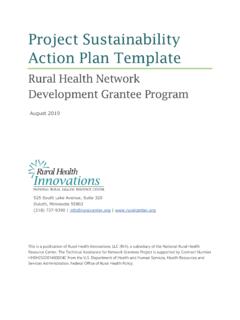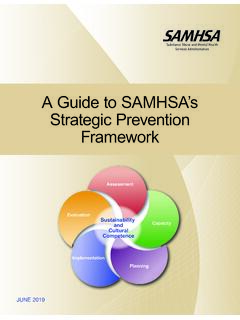Transcription of What is monitoring? - United Nations Office on Drugs and …
1 540 toolkit to Combat Trafficking in Persons Tool Overview of monitoring and evaluation Overview This tool briefly describes both monitoring and evaluation, and the distinction between the two. What is monitoring ? monitoring is a continuing function that uses systematic collection of data on specific indi- cators to provide the management and the main stakeholders of an ongoing intervention with indications of the extent of achievement of objectives and progress in the use of allocated funds. Indicators An indicator is a quantitative or qualitative variable that allows changes produced by an intervention relative to what was planned to be measured.
2 It provides a reasonably simple and reliable basis for assessing achievement, change or performance. An indicator is preferably numerical and can be measured over time to show changes. Indicators, which are determined during the planning phase of a project, usually have the following components: 1. What is to be measured? (What is going to change? , participants reporting higher school attendance of girls in a village). 2. Unit of measurement to be used (to describe the change, , percentage). 3.
3 Pre-programme status (sometimes called the baseline , , 40 per cent in 2007). 4. Size, magnitude or dimension of intended change ( , 75 per cent in 2008). 5. Quality or standard of the change to be achieved ( , improvement such that girls obtain higher grades). 6. Target populations(s) ( , girls vulnerable to trafficking from villages in southern district). 7. Time frame ( , January 2008 to January 2009). chapter 10 monitoring and evaluation 541. What is evaluation? Evaluation is the systematic and objective assessment of ongoing and/or completed projects, programmes or policies, in respect of their: Design Implementation Results The criteria applied in the evaluation are: Objectives Efficiency Effectiveness Impact Sustainability Evaluation emphasizes the assessment of outcomes and impact rather than the delivery of outputs.
4 See the Evaluation Quality Standards available at: i ,3343,en_2649_34435_16557149_1_1_. 1_1, Norms for evaluation United Nations Evaluation Group In April 2005, the United Nations Evaluation Group issued norms and standards with a view to the harmonization of evaluation in the United Nations system. The United Nations Evaluation Group norms seek to facilitate system-wide collaboration on evaluation, by ensuring that evaluation within the United Nations system abides by agreed-upon basic principles: Intentionality (intent to use evaluation findings).
5 Impartiality Independence Evaluability Quality Competence 542 toolkit to Combat Trafficking in Persons Transparency and consultation Evaluation ethics Follow-up Contribution to knowledge building The United Nations Evaluation Group norms and standards are i available in Chinese, English, French, Russian and Spanish at: Distinguishing between monitoring and evaluation monitoring Evaluation Timing monitoring is a continuing Evaluation assesses the function that takes place entire project cycle. throughout the implementation of a project/programme.
6 Depth and monitoring is a regular part Evaluation reviews the purpose of project or programme achievements of the project/. management. It focuses on programme and considers the implementation of the whether the plan was the project, comparing what is best one to achieve the delivered with what was outcomes. planned. Evaluation measures achievements, as well as positive/ negative and intended/ unintended effects. Evaluation looks for lessons to be learned from both success and lack of success, and also looks for best practices which can be applied elsewhere.
7 Who conducts it monitoring is usually done Evaluation is best conducted by people directly involved by an independent outsider in implementing the project/ who can be impartial in programme. consulting with project/. programme staff. Relationship Data collected and insights gained in the course of monitoring between are then fed into and used by the evaluation process. monitoring and evaluation chapter 10 monitoring and evaluation 543. Recommended resources There are various organizations and resources dedicated to the harmonization and improve- ment of monitoring and evaluation.
8 Many of these may offer lessons with respect to the monitoring and evaluation of anti-trafficking programmes. The following is just a small selec- tion of the resources available. How to Build M&E Systems to Support Better Government Keith Mackay, World Bank Independent Evaluation Group, 2007. A resource designed particularly for Governments in developing countries seeking to strengthen their monitoring and evaluation systems, this publication includes promising mon- itoring and evaluation system practice, as well as diagnostic guides, examples of evaluations and other tools for strengthening the monitoring and evaluation systems of Governments.
9 The efforts to build monitoring and evaluation systems of Chile, Colombia and Australia, in particular, are considered, and Africa is given attention as a special case. The report can be downloaded in English at: i monitoring and Evaluation: Some Tools, Methods and Approaches World Bank Independent Evaluation Group, 2004. This booklet provides an overview of monitoring and evaluation tools, methods and approaches, including data collection methods, analytical frameworks and types of evalua- tion and review.
10 The purpose, use, advantages and disadvantages, costs, skill requirements, time requirements and key references are provided for: Performance indicators The logical framework approach Theory-based evaluation Formal surveys Rapid appraisal methods Participatory methods Public expenditure tracking surveys Impact evaluation Cost-benefit and cost-effectiveness analysis The booklet is available in Arabic, English, French, Portuguese, Russian i and Spanish, at: 544 toolkit to Combat Trafficking in Persons Network on Development Evaluation of the Development Assistance Committee The Network on Development Evaluation is a subsidiary body of the Development Assistance Committee supported by the secretariat of the Organization for Economic Cooperation and Development.















